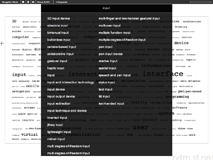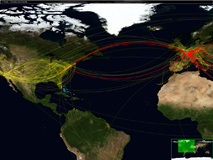Introduction
ZUIST is a generic multi-scale scene engine/API for ZVTM which makes it easier for developers to create zoomable/multi-scale interfaces in which objects representing a scene at varying levels of detail are loaded/unloaded dynamically to/from memory depending on the region of the virtual space scene through the camera(s). Multi-scale scenes can be built through the ZUIST API (javadoc) or can be loaded from files that describe them declaratively using a dedicated, simple XML vocabulary.
Applications
Gigapixel Image Viewer
This image viewer makes it possible to visualize any large image (one or more gigapixels). It provides smooth zooming and panning capabilities in the image, as well as tools to ease navigation (overview+detail, fisheye lens, speed-coupled blending lens). The original image is first processed by a Python script that generates a ZUIST scene (consisting of a pyramid of tiles). The Python script makes use of either Apple's Core Graphics API, or PIL + Image Magick (if not running on a Mac). The ZUIST scene representing a multi-scale version of the original image can then be loaded in the Java viewer.
The Infrared Milky Way - Spitzer Space Telescope (396 032 x 27 040 pixels)
Credit: NASA/JPL-Caltech/(Univ. of Wisconsin) - IRAC, MIPS
Yosemite 17 gigapixels (214 414 x 80 571 pixels)
Credit: Gerard Maynard
Image displayed on our WILD high-resolution interactive visualization platform.
Carina Nebula (29 566 x 14 321 pixels)
Credit: NASA, ESA, N. Smith (University of California, Berkeley), and The Hubble Heritage Team (STScI/AURA)
Sikh Golden Temple, or Harmandir Sahib, in India (37 049 x 8 500 pixels)
Photographer credit: Matt Deans
UIST Archive Explorer
UIST Explorer is a ZUIST-based application that lets users navigate in 20 years of papers published at the ACM UIST conference from 1988 to 2007. It was one of the 20th Anniversary Interactive Visualization tools demonstrated during the 2007 conference. Users have access to 578 research papers, typically 4-to-10 page long. Papers can be browsed by year, by author, or by keywords. Overall, the multi-scale scene is composed of more than 80,000 graphical objects, most of them being 1 224 x 1 584 pixels compressed bitmap images (representing about 2GB of compressed data), loaded dynamically into memory. Running UIST Explorer typically requires less than 512MB of RAM. During the conference, the application ran on an Apple MacBook Pro laptop hooked to a SmartBoard 3000i (see pictures and videos below), with a Java heap size set to 1GB, of which it never used more than 50%.
XML description of the scene (1.5 MB ZIP file), Java code
Additional pictures and videos from the UIST 20th anniversary celebration are available on the ACM UIST archive Web site.
Videos
- Teaser for the ACM UIST conference 20th anniversary. (Quicktime H.264)
- Video of a UIST attendent interacting with ZUIST on a SmartBoard 3000i (YouTube)
Blue Marble Next Generation Explorer
Navigating in a multi-scale version of NASA's Blue Marble Next Generation world map: 86 400 x 43 200 pixels decomposed into 2 730 tiles (1 350 x 1 350 each) arranged in a pyramid. The map is enriched with geographical data taken from the Geonames database and boundaries for countries and administrative regions publicly available as ESRI shapefiles.
XML description of the scene (42 KB ZIP file), Java code
Videos
- Video demonstration. (Quicktime H.264 HD - 67MB)
- Companion video associated with a paper published at ACM CHI'07 about multi-scale searching. The video's last 40 seconds show the Blue Marble world map. (Quicktime H.264)
LRI Explorer
An application similar to UIST Explorer was developed to navigate in all research documents published by members of LRI, the computer science lab at Université Paris-Sud between 2005 and 2008, ranging from book chapters, journal and conference papers to PhD dissertations and tech reports. Documents can be browsed by author or by team, and are then organized by type of publication and year of publication, down to the level where the pages of each document appear (when a PDF version is available). The total number of documents is about 1,500. A PDF version of the document is available for 753 of them, amounting to about 15,000 pages actually readable directly within the application.
Videos
- Navigation to a research paper, and then to a PhD dissertation (4.2MB - 640x480 - Quicktime H.264)
Documentation
For now, only the Javadoc API documentation is available, along with code examples from various applications: the basic viewer/debugger, UIST Archive Explorer, and Blue Marble Next Generation Explorer.






















